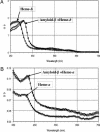A role for heme in Alzheimer's disease: heme binds amyloid beta and has altered metabolism
- PMID: 15263070
- PMCID: PMC503755
- DOI: 10.1073/pnas.0404349101
A role for heme in Alzheimer's disease: heme binds amyloid beta and has altered metabolism
Abstract
Heme is a common factor linking several metabolic perturbations in Alzheimer's disease (AD), including iron metabolism, mitochondrial complex IV, heme oxygenase, and bilirubin. Therefore, we determined whether heme metabolism was altered in temporal lobes obtained at autopsy from AD patients and age-matched nondemented subjects. AD brain demonstrated 2.5-fold more heme-b (P < 0.01) and 26% less heme-a (P = 0.16) compared with controls, resulting in a highly significant 2.9-fold decrease in heme-a/heme-b ratio (P < 0.001). Moreover, the strong Pearson correlation between heme-a and heme-b measured in control individuals (r(2) = 0.66, P < 0.002, n = 11) was abolished in AD subjects (r(2) = 0.076, P = 0.39, n = 12). The level of ferrochelatase (which makes heme-b in the mitochondrial matrix) in AD subjects was 4.2 times (P < 0.04) that in nondemented controls, suggesting up-regulated heme synthesis. To look for a possible connection between these observations and established mechanisms in AD pathology, we examined possible interactions between amyloid beta (A beta) and heme. A beta((1-40)) and A beta((1-42)) induced a redshift of 15-20 nm in the spectrum of heme-b and heme-a, suggesting that heme binds A beta, likely to one or more of the histidine residues. Lastly, in a tissue culture model, we found that clioquinol, a metal chelator in clinical trials for AD therapy, decreased intracellular heme. In light of these observations, we have proposed a model of AD pathobiology in which intracellular A beta complexes with free heme, thereby decreasing its bioavailability (e.g., heme-a) and resulting in functional heme deficiency. The model integrates disparate observations, including A beta, mitochondrial dysfunction, cholesterol, and the proposed efficacy of clioquinol.
Figures







Similar articles
-
Heme binding to Amyloid-beta peptide: mechanistic role in Alzheimer's disease.J Alzheimers Dis. 2006 Nov;10(2-3):255-66. doi: 10.3233/jad-2006-102-310. J Alzheimers Dis. 2006. PMID: 17119291 Review.
-
Amino acids variations in amyloid-beta peptides, mitochondrial dysfunction, and new therapies for Alzheimer's disease.J Bioenerg Biomembr. 2009 Oct;41(5):457-64. doi: 10.1007/s10863-009-9246-2. J Bioenerg Biomembr. 2009. PMID: 19806442 Review.
-
Heme, iron, and the mitochondrial decay of ageing.Ageing Res Rev. 2004 Jul;3(3):303-18. doi: 10.1016/j.arr.2004.02.002. Ageing Res Rev. 2004. PMID: 15231238 Review.
-
Amyloid-beta peptide binds with heme to form a peroxidase: relationship to the cytopathologies of Alzheimer's disease.Proc Natl Acad Sci U S A. 2006 Feb 28;103(9):3381-6. doi: 10.1073/pnas.0600134103. Epub 2006 Feb 21. Proc Natl Acad Sci U S A. 2006. PMID: 16492752 Free PMC article.
-
Interactions between amyloid-β and hemoglobin: implications for amyloid plaque formation in Alzheimer's disease.PLoS One. 2012;7(3):e33120. doi: 10.1371/journal.pone.0033120. Epub 2012 Mar 6. PLoS One. 2012. PMID: 22412990 Free PMC article.
Cited by
-
Insulin Resistance and Diabetes Mellitus in Alzheimer's Disease.Cells. 2021 May 18;10(5):1236. doi: 10.3390/cells10051236. Cells. 2021. PMID: 34069890 Free PMC article. Review.
-
Alzheimer's disease: diverse aspects of mitochondrial malfunctioning.Int J Clin Exp Pathol. 2010 Jun 25;3(6):570-81. Int J Clin Exp Pathol. 2010. PMID: 20661404 Free PMC article. Review.
-
Neuroprotective effects of berberine on recognition memory impairment, oxidative stress, and damage to the purinergic system in rats submitted to intracerebroventricular injection of streptozotocin.Psychopharmacology (Berl). 2019 Feb;236(2):641-655. doi: 10.1007/s00213-018-5090-6. Epub 2018 Oct 30. Psychopharmacology (Berl). 2019. PMID: 30377748
-
Metal Binding to Aβ Peptides Inhibits Interaction with Cytochrome c: Insights from Abiological Constructs.ACS Omega. 2018 Oct 25;3(10):13994-14003. doi: 10.1021/acsomega.8b01736. eCollection 2018 Oct 31. ACS Omega. 2018. PMID: 31458095 Free PMC article.
-
A brain proteomic signature of incipient Alzheimer's disease in young APOE ε4 carriers identifies novel drug targets.Sci Adv. 2021 Nov 12;7(46):eabi8178. doi: 10.1126/sciadv.abi8178. Epub 2021 Nov 10. Sci Adv. 2021. PMID: 34757788 Free PMC article.
References
-
- Schipper, H. M., Cisse, S. & Stopa, E. G. (1995) Ann. Neurol. 37, 758–768. - PubMed
-
- Kimpara, T., Takeda, A., Yamaguchi, T., Arai, H., Okita, N., Takase, S., Sasaki, H. & Itoyama, Y. (2000) Neurobiol. Aging 21, 551–554. - PubMed
-
- Steffens, G. C., Biewald, R. & Buse, G. (1987) Eur. J. Biochem. 164, 295–300. - PubMed
-
- Maurer, I., Zierz, S. & Moller, H. J. (2000) Neurobiol. Aging 21, 455–462. - PubMed
Publication types
MeSH terms
Substances
LinkOut - more resources
Full Text Sources
Other Literature Sources
Medical

